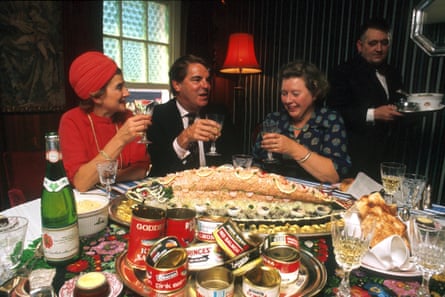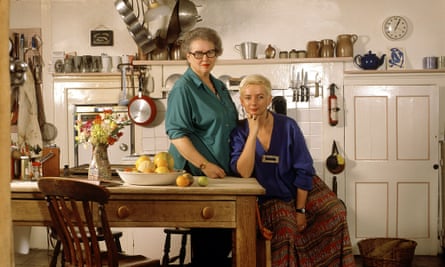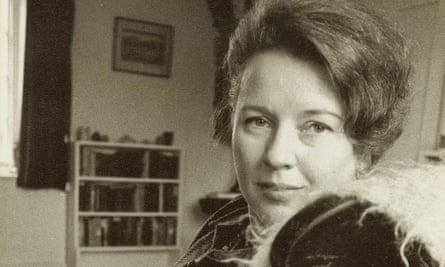Regular customers at Quo Vadis in Soho, a restaurant that has been open more or less continuously since 1926, will know that in its present incarnation certain treats are always on the menu. Among these, listed in the section of salty, savoury things you might just enjoy with a pre-dinner sharpener, are kickshaws, which are deep-fried pastry parcels, usually with a chicken filling. Another is bloater paste, a light pâté of cured herrings topped with clarified butter that is delicious served on good brown toast.
These are old-fashioned delights. The word “kickshaw” is a scornful Anglicisation of the French quelque chose – “some odd thing or other” – whose history can be traced to the 16th century: a supper of “a joint of mutton and any pretty little kickshaws” is prepared for Falstaff in Henry IV, Part 2. Bloater paste, meanwhile, has a Dickensian air: it makes you think of pea soupers and a stinking Thames – though this is very unfair. When Peggotty in David Copperfield refers to herself as a “Yarmouth bloater”, what she means is that she is a plump, sweet and delicious character, one whom any man with blood in his veins would admire (traditionally, the best bloaters come from Great Yarmouth).
Recipes for both kickshaws and bloater paste can be found in Jane Grigson’s 1974 classic English Food – though her kickshaws, filled with jam, are designed to be served as pudding, sprinkled with sugar – and it’s thanks to this that they’re on the Quo Vadis menu. “I’m the youngest of three boys, and my mother wisely kept me close while the other two were plotting to kill me,” its chef Jeremy Lee tells me in the bar one day after lunch. “In her kitchen, she had this lovely perch, and there she’d be, coffee in one hand, index finger of the other moving down the page of a cookbook. And there was always Jane, particularly Good Things, which I think her best. It does what a good cookbook should, which is to lure you into the kitchen.”
He emits a contented sigh. “Oh, the delightful anecdotes, the little gasps along the way!”
Lee and I are talking about Grigson, the Observer’s celebrated cookery writer, by way of marking the anniversary of her death, 25 years ago this month (she wrote for the paper every Sunday from 1968 right until the end). Loved by readers for the dextrous way she combined scholarship with sound advice – her recipes, succinct but never vague, are difficult to muck up – she left behind at least a dozen books that might reasonably be called classics, each one fat with recipes, history and stories. And yet – the thought seems to occur to us both at the same moment – she is, at least compared to her friend and mentor Elizabeth David, relatively little known today, particularly among younger cooks. A couple of her books have even fallen out of print. How can this be, in this the food-obsessed 21st century? It is, we agree, completely unfathomable.
“And all the more so because she has been so fantastically influential,” says Lee. As he points out, her kind of food has never been more popular, even if people don’t realise this is what they’re eating. (“Those who know her books, and love them, feel this neglect as a gross insult,” he says. “But those who don’t, well…”) Think not only of Quo Vadis, or of St John a little way east, but also of younger, hipper establishments such as the revamped Quality Chop House in Clerkenwell, or its new sister restaurant, Portland, or the Sportsman at Seasalter in Kent, or any number of other places. Grigson would have loved them all.

How to explain this relative obscurity? Answers are hard to come by. “I can’t, really,” says Jill Norman, a former publisher of Grigson’s. “So much that she wrote about is important now: foraging, for instance, and regional food. It certainly has nothing to do with the books, because the erudition in them is worn very lightly, and everything in them is just… right.” Prue Leith, another friend, agrees: “Oh, she was way ahead of her time in terms of the glory of the carrot!” Simon Hopkinson, a longtime fan, wonders if it doesn’t have something to do with a certain kind of snobbery, for while Elizabeth David had a complex private life and a flinty, rackety glamour that was all her own – exactly the kind of charisma that attracts biographers and producers of BBC4 biopics – Grigson was known only for being generous, warm, kind and, above all, happily married.
“Perhaps people think of her as housewifely,” he says. “You see, Jane is very practical, she wants to give you information, whereas with Elizabeth it’s more a case of going to Amalfi to buy some lemons.” He’s joking, but what he says does chime with a well-known (and possibly apocryphal) story people like to tell about David and Grigson. It goes like this. On the telephone one day, Jane complained to Elizabeth that she was at a loss as to what to make for her young daughter’s tea.
Elizabeth, who had no children, duly suggested that baked beans would probably fit the bill, to which Jane could only wail: “Yes, but they take so long to make!”
Is it possible to introduce Grigson to a new generation, one reared on pop-ups, TV competitions, recherché ingredients, endless queues for the right tables, allotment chic and dirty burgers? Surely it must be. If you want to know how to make, say, a comfrey fritter or jugged hare, then Grigson is your first port of call; she was Soho hip when the cooks at the likes of Duck Soup were still in nappies. But she can talk to the Bake-Off crowd, too: there is, for instance, a whole chapter devoted to tea in English Food. “I love her Sussex pond pudding,” says Simon Hopkinson (this is a suet pudding with a whole lemon buried in its heart, and Grigson thought it the best of all English boiled puddings). “And if you’ve a glut of apples, then go straight to the fruit book.” Jeremy Lee, meanwhile, thinks she’s just the ticket as proper butchery enjoys its biggest revival since the war.
“She’s very satisfying on terrines and pies,” he says. “All the offcuts: she knows exactly what to do with them.” As for me, well, if you’re into “artisanal” ice cream look no further than her recipe for brown bread ice cream. Not only is it delicious, it can be made in the tiniest flat, with the tiniest freezer, for the simple reason that, miraculously, it needs no churning.
Jane Grigson was born in 1928 in Gloucester, where her father was the deputy town clerk; her mother, a “good, but dull cook”, was an artist. When she was just four, however, the family moved to Sunderland. Wearside would have a profound effect on Jane – her books often include recipes from the north east – and a trace of it could be heard in her voice right until the end of her life; the sight of the city’s slums also turned her into a socialist. During the war, though, the area was a favoured target of the Luftwaffe, and Jane and her sister, Mary, were sent to board at Casterton School near Kirkby Lonsdale in Cumbria. There, she was taught English by a Miss Bevis, whose encouragement helped her to win a place at Cambridge.
After university, she worked in a Cambridge gallery while furiously applying for posts at the V&A (she was fascinated by painting, silver and textiles). But again and again, having no real expertise, she was turned down. In 1953, then, she applied for a job as a picture researcher at Thames & Hudson, whose publisher George Rainbird had commissioned a vast encyclopaedia, People, Places, Things and Ideas.
This volume’s editor was the irascible poet Geoffrey Grigson, who caught a glimpse of Jane through a crack in the door as she waited to be called to her interview. According to Joy Law, his colleague at Thames & Hudson, Jane was sitting primly upright, in a dark plaid dress with a neat voile collar, and a tiny hat perched on her tightly coiled blonde hair. “What an enchanting plump Dutch interior,” murmured Grigson.
Jane got the job and, not too long afterwards, she got Grigson, too (he was not put off by the hat that looked “like a chamber pot”). The circumstances of their union were not particularly auspicious. Twenty-three years her senior, Grigson was still married to his second wife, with whom he had three children; he was permanently broke, and had a Webster-ish preoccupation with death, the result, no doubt, of too much early sorrow (three of Grigson’s brothers had been killed in the first world war, and three during the second). He and Jane would not be free to marry for 20 years.

But none of this put her off. She’d worshipped Grigson the writer since she was 15, when she had bought a copy of his anthology The Poet’s Eye, and now she was working with him – she would stay late into the night, showing him illustrations which he would then promptly reject – she could only admire his forthrightness: as she later confided to her friend the novelist Paul Bailey, Geoffrey would say aloud things she only dared think. “She chortled when he was being caustic about writers and painters – there were lots – he considered overrated,” says Bailey. “But that was the closest she ever came to cattiness. Jane spread benevolence wherever she went.”
Theirs was a famously happy marriage, which ended only with Geoffrey’s death in 1985, a loss from which Jane struggled to recover. “They lived for each other,” says Jill Norman. “They were devoted to each other, utterly. When they met, he was much the better known, and she greatly regarded what he thought. But when she became successful, he fell happily into line behind her.” They shared an abiding interest in the origins of things, in their roots. For Geoffrey, this revealed itself in such books as his classic guide to the British countryside, The Shell Country Alphabet.
Jane, on the other hand, always longed to know how a dish had come by its name, why it was popular in this or that place, and whether a recipe for it might be found in any 18th or 19th century text.
Jane moved into Broad Town Farm House, Geoffrey’s home in Wiltshire, and their life together began. “Geoffrey lived by his pen,” she once said, “and I had no money. I remember hiding from the milkman because I couldn’t pay the bill.”
Elizabeth David recalled Jane telling her that for many years, she could not afford a fridge. In 1959, their daughter Sophie was born. Soon afterwards, courtesy of a tiny sum given to her by her father, she and Grigson bought a three-and-a-half room cave house at Troo, in the Loire Valley, and thanks to what she called this “troglodytic existence”, her new career was born. Fascinated by the skills of her new neighbours, she began researching their ways with pigs and brine. This led, eventually, to the publication in 1967 of Charcuterie and French Pork Cookery, a book that immediately marked her out as a new talent. “For us in England… it was a real novelty,” remembered David. “Here was a writer who could combine a delightful quote from Chaucer on the subject of pike galantine with a careful recipe for a modern chicken and pork version of the same ancient dish, and who could do so without pedantry or a hint of preciousness.”
David read the book in typescript, not yet having met its author. Only later did Grigson’s editor, Anthea Joseph, invite both women to lunch. Afterwards, David took Grigson to her Pimlico shop to admire the stoneware salting jars and rillette pots she was importing from France, and thus began their rather surprising friendship (David tended to prefer male company to female). On Sunday mornings, they would speak on the telephone, long conversations that took in “anything from medieval English bread laws to 18th-century French ice creams”. It was David who recommended Grigson to the Observer. “Not that she needed deadlines,” says Norman. “I never once heard her say: what on earth am I going to do this week?”
She seemed, if anything, to have a surfeit of ideas. The acclaimed and award-winning books that followed – among them Fish Cookery (1973), English Food (1974), The Mushroom Feast (1975), Jane Grigson’s Vegetable Book (1978) and Jane Grigson’s Fruit Book (1982) – had always to be edited down, reduced like good sauces.
If David introduced postwar cooks to the pleasures of the Mediterranean, it was Grigson who reminded them that British cooking, then so beleaguered, had its own rich history; her touchstones included Dorothy Hartley and Florence White, Eliza Acton and Mrs Rundell. Unlike David, her instincts were rural rather than urban. An early critic of battery farming, she cared passionately, too, about such things as provenance. “She became quite politicised,” says Sophie Grigson. “She was angry that people were becoming deskilled and disconnected from food’s origins. She would have loved farmers’ markets. She would have been thrilled to see people caring about producers again.”

Above all, though, she was someone for whom cooking was only ever a pleasure (contrast this with David, who in old age lived on Nescafe and Roka biscuits). “She thought food was the key to unlocking life,” says Sophie. The dishes her mother loved best were sensible, unfussy, just like her. Sophie associates her with Grasmere gingerbread (“A crumbly biscuit, not in the least like our usual soft, dark gingerbread,” Jane writes of it in English Food, before quoting from Dorothy Wordsworth) and, when the family was in France, a dish of cured herring, creme fraiche and apple. Jenny Dereham, Jane’s former editor, remembers her roast chicken, “beautifully flavoured, nothing fancy”, and Paul Bailey a simple picnic of bread, cheese and salami eaten on the banks of Loch Ness. (After Geoffrey’s death, he and Jane embarked on a Scottish tour, their first stop the Peat Inn at Fife, where they ate delectable little pots of chocolate flavoured with rosemary, the recipe for which they eventually persuaded its chef to hand over.)
Jane once said that she found cooking far more satisfactory than painting pictures or throwing pots: “Food has the tact to disappear, leaving the room and opportunity for masterpieces to come,” she wrote. “The mistakes don’t hang on the walls or stand on the shelves to reproach you for ever.” You get a sharp sense of this when you read her recipes, which evince a quiet confidence, a feeling that everything will turn out all right. “She believed everyone had the ability to be a good cook,” says Bailey. “Good being the appropriate word. This was at a time when chefs were comparing themselves to artists of genius, and people took that seriously.”
Her attitude to the cancer that killed her was just as straightforward. “Sod it all,” she would say. She died at the age of just 62, leaving behind a library in which a cook, or even just a greedy person, can very quickly become lost – her archive is now in the care of Oxford Brookes University – and at least one bona fide classic recipe of her own invention: spiced parsnip soup, a dish today so ubiquitous, you can buy it in a supermarket carton (something that may or may not have amused her). In the hours after her death, however, her family enjoyed a more ephemeral legacy. “We were sitting around, shell-shocked,” says Sophie. “But then I found a Murrumbidgee cake in her larder. A beautiful thing: rich, dense, a favourite of hers. I cut slices of it, and we ate them, and it was wonderful. Her last gift to us.”
Murrumbidgee cake, a boozy confection of crystallised fruit and nuts, takes its name from an Australian river. Nevertheless, a recipe for it is to be found in English Food – Jane had once been in the habit of buying it from a baker in north Oxford – and after I finish talking to Sophie, I go downstairs to look it up. Bath buns, seed cake, lardy cake, stuffed monkeys… The next time I glance at my watch, an hour has gone by.
Jane Grigson: Good Things is at the Abercrombie Building, Oxford Brookes University until 2 April; The Best of Jane Grigson – The Enjoyment of Food will be published in May by Grub Street. Go to the Guardian Bookshop to order a copy of this and other Jane Grigson books; janegrigsontrust.org.uk

Comments (…)
Sign in or create your Guardian account to join the discussion